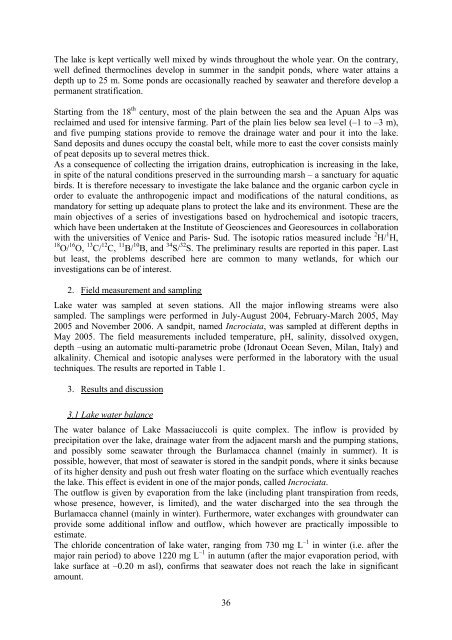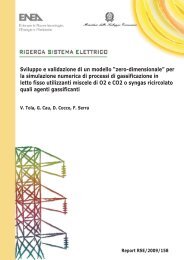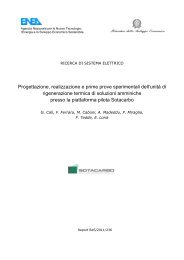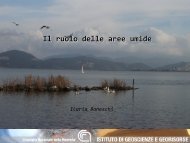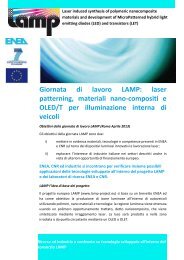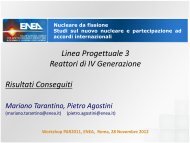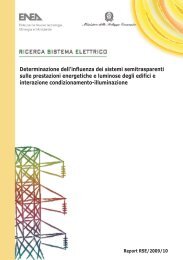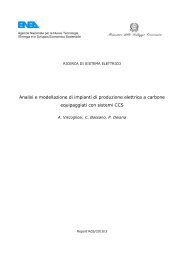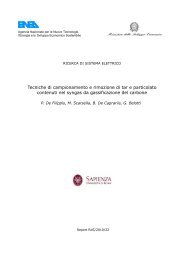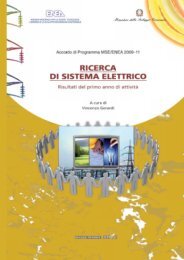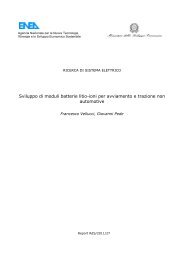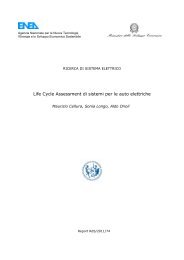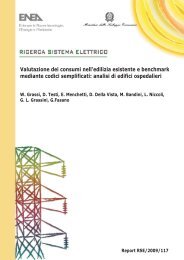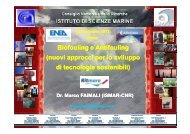scaricabile in rete - Enea
scaricabile in rete - Enea
scaricabile in rete - Enea
Create successful ePaper yourself
Turn your PDF publications into a flip-book with our unique Google optimized e-Paper software.
The lake is kept vertically well mixed by w<strong>in</strong>ds throughout the whole year. On the contrary,<br />
well def<strong>in</strong>ed thermocl<strong>in</strong>es develop <strong>in</strong> summer <strong>in</strong> the sandpit ponds, where water atta<strong>in</strong>s a<br />
depth up to 25 m. Some ponds are occasionally reached by seawater and therefore develop a<br />
permanent stratification.<br />
Start<strong>in</strong>g from the 18 th century, most of the pla<strong>in</strong> between the sea and the Apuan Alps was<br />
reclaimed and used for <strong>in</strong>tensive farm<strong>in</strong>g. Part of the pla<strong>in</strong> lies below sea level (–1 to –3 m),<br />
and five pump<strong>in</strong>g stations provide to remove the dra<strong>in</strong>age water and pour it <strong>in</strong>to the lake.<br />
Sand deposits and dunes occupy the coastal belt, while more to east the cover consists ma<strong>in</strong>ly<br />
of peat deposits up to several metres thick.<br />
As a consequence of collect<strong>in</strong>g the irrigation dra<strong>in</strong>s, eutrophication is <strong>in</strong>creas<strong>in</strong>g <strong>in</strong> the lake,<br />
<strong>in</strong> spite of the natural conditions preserved <strong>in</strong> the surround<strong>in</strong>g marsh – a sanctuary for aquatic<br />
birds. It is therefore necessary to <strong>in</strong>vestigate the lake balance and the organic carbon cycle <strong>in</strong><br />
order to evaluate the anthropogenic impact and modifications of the natural conditions, as<br />
mandatory for sett<strong>in</strong>g up adequate plans to protect the lake and its environment. These are the<br />
ma<strong>in</strong> objectives of a series of <strong>in</strong>vestigations based on hydrochemical and isotopic tracers,<br />
which have been undertaken at the Institute of Geosciences and Georesources <strong>in</strong> collaboration<br />
with the universities of Venice and Paris- Sud. The isotopic ratios measured <strong>in</strong>clude 2 H/ 1 H,<br />
18 O/ 16 O, 13 C/ 12 C, 11 B/ 10 B, and 34 S/ 32 S. The prelim<strong>in</strong>ary results are reported <strong>in</strong> this paper. Last<br />
but least, the problems described here are common to many wetlands, for which our<br />
<strong>in</strong>vestigations can be of <strong>in</strong>terest.<br />
2. Field measurement and sampl<strong>in</strong>g<br />
Lake water was sampled at seven stations. All the major <strong>in</strong>flow<strong>in</strong>g streams were also<br />
sampled. The sampl<strong>in</strong>gs were performed <strong>in</strong> July-August 2004, February-March 2005, May<br />
2005 and November 2006. A sandpit, named Incrociata, was sampled at different depths <strong>in</strong><br />
May 2005. The field measurements <strong>in</strong>cluded temperature, pH, sal<strong>in</strong>ity, dissolved oxygen,<br />
depth –us<strong>in</strong>g an automatic multi-parametric probe (Idronaut Ocean Seven, Milan, Italy) and<br />
alkal<strong>in</strong>ity. Chemical and isotopic analyses were performed <strong>in</strong> the laboratory with the usual<br />
techniques. The results are reported <strong>in</strong> Table 1.<br />
3. Results and discussion<br />
3.1 Lake water balance<br />
The water balance of Lake Massaciuccoli is quite complex. The <strong>in</strong>flow is provided by<br />
precipitation over the lake, dra<strong>in</strong>age water from the adjacent marsh and the pump<strong>in</strong>g stations,<br />
and possibly some seawater through the Burlamacca channel (ma<strong>in</strong>ly <strong>in</strong> summer). It is<br />
possible, however, that most of seawater is stored <strong>in</strong> the sandpit ponds, where it s<strong>in</strong>ks because<br />
of its higher density and push out fresh water float<strong>in</strong>g on the surface which eventually reaches<br />
the lake. This effect is evident <strong>in</strong> one of the major ponds, called Incrociata.<br />
The outflow is given by evaporation from the lake (<strong>in</strong>clud<strong>in</strong>g plant transpiration from reeds,<br />
whose presence, however, is limited), and the water discharged <strong>in</strong>to the sea through the<br />
Burlamacca channel (ma<strong>in</strong>ly <strong>in</strong> w<strong>in</strong>ter). Furthermore, water exchanges with groundwater can<br />
provide some additional <strong>in</strong>flow and outflow, which however are practically impossible to<br />
estimate.<br />
The chloride concentration of lake water, rang<strong>in</strong>g from 730 mg L –1 <strong>in</strong> w<strong>in</strong>ter (i.e. after the<br />
major ra<strong>in</strong> period) to above 1220 mg L –1 <strong>in</strong> autumn (after the major evaporation period, with<br />
lake surface at –0.20 m asl), confirms that seawater does not reach the lake <strong>in</strong> significant<br />
amount.<br />
36


